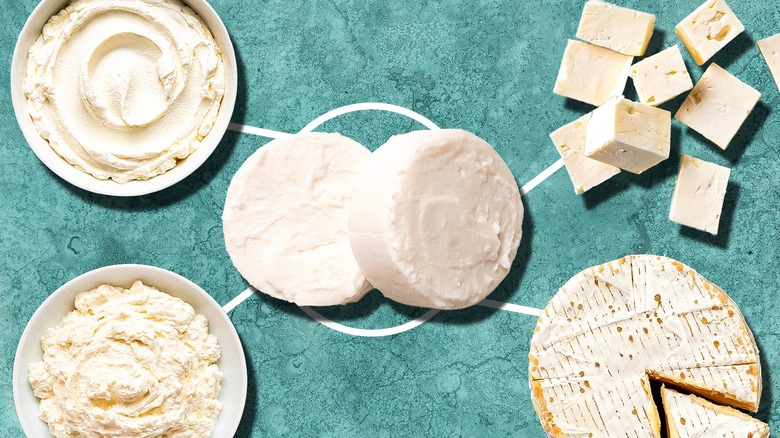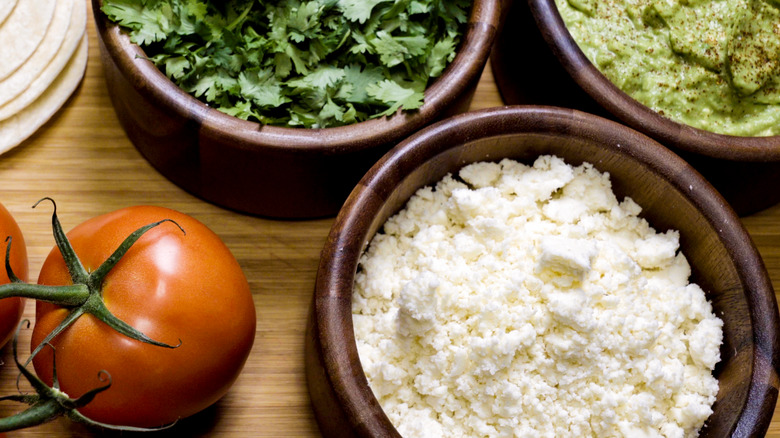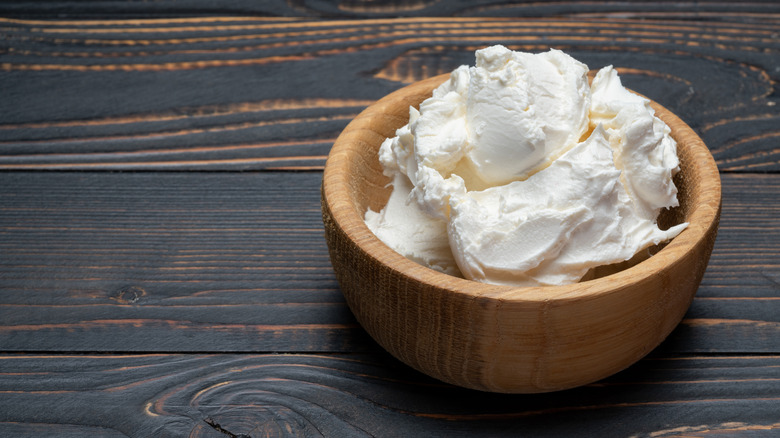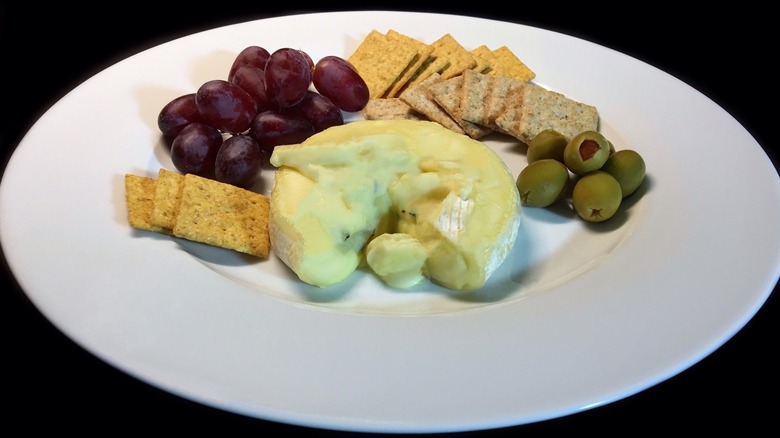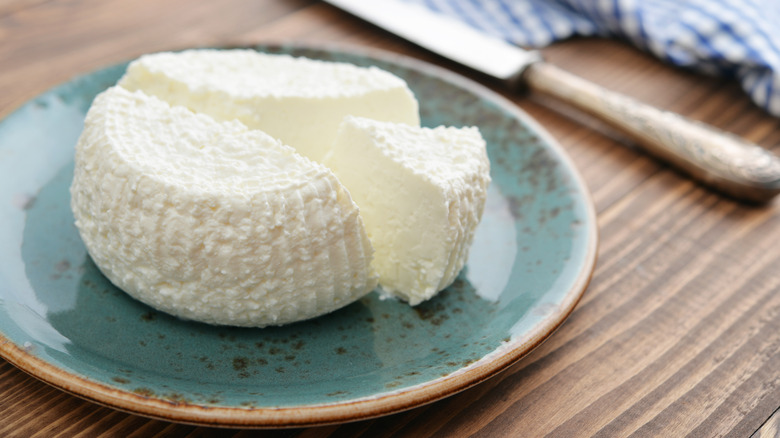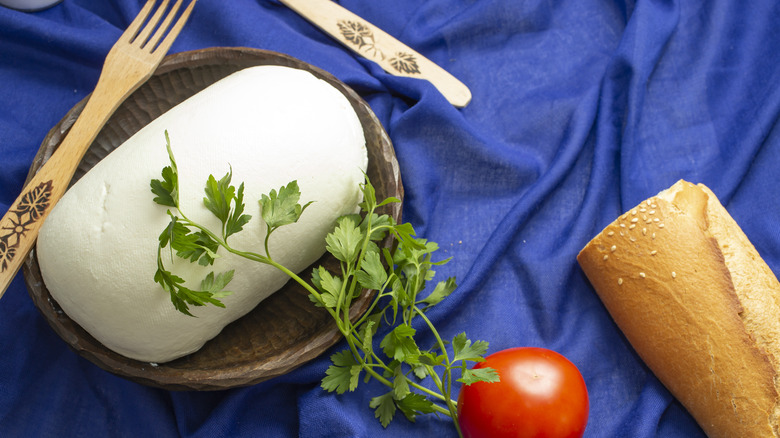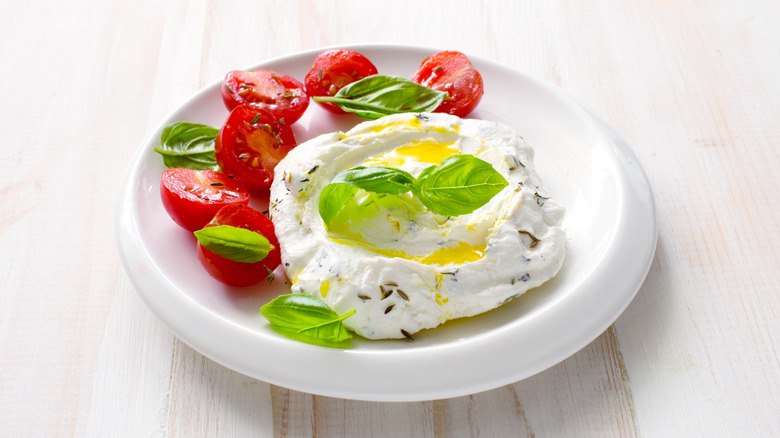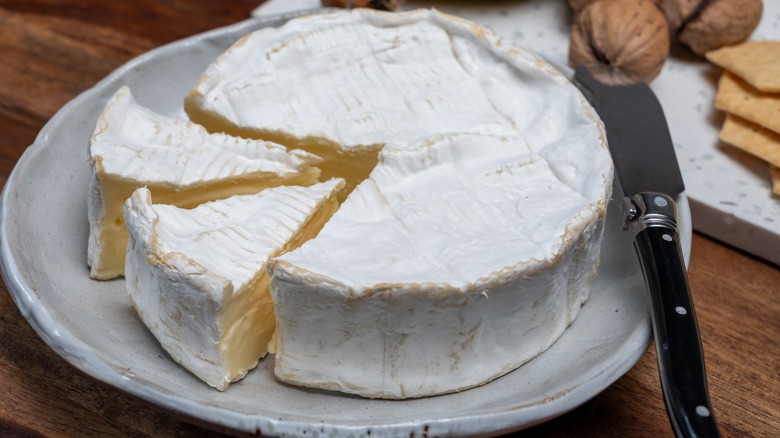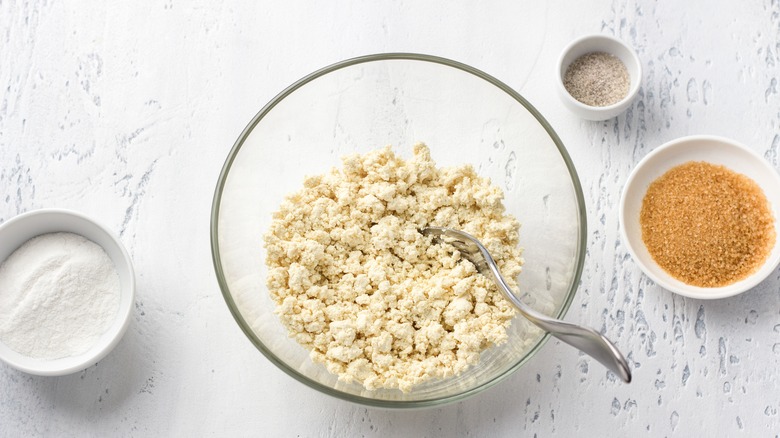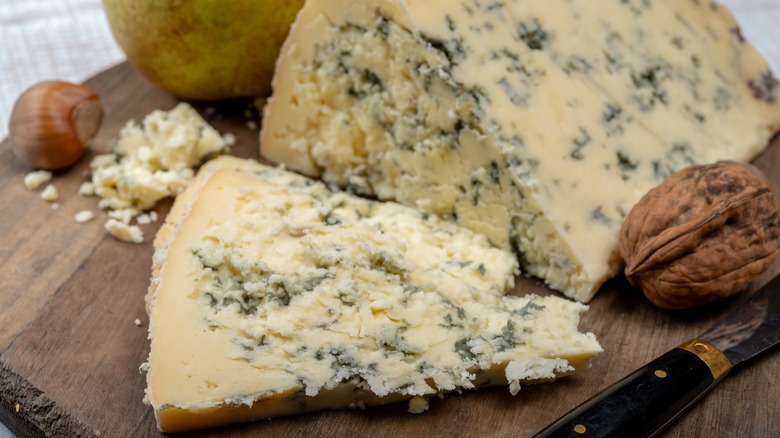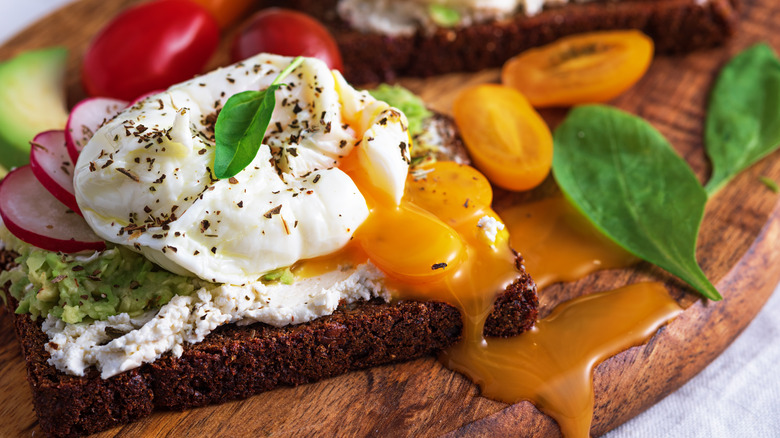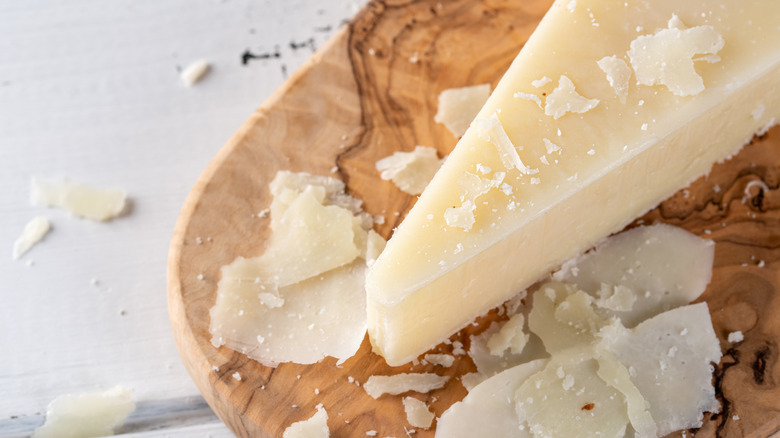12 Best Substitutes For Goat Cheese
Food trends come and go every year, but a few ingredients just seem to have a "cool factor" that gives them a trend-resistant popularity. Goat cheese is one of those ingredients.
Fresh goat cheese — sometimes known by its French name, chèvre — is an appealing ingredient that brings creaminess, tang, and a distinctive flavor anywhere it's used (there are aged goat cheeses as well, but it's the fresh kind that most recipes call for). It's also much whiter than cow's milk cheeses in the same style, which means it makes a visually striking contrast with colorful foods.
If you find yourself looking at a recipe built around goat cheese but can't find it at your local store, or if it doesn't fit your budget, or if you just don't care for its distinctive "goatiness," many substitutes can hit some of the same flavor and textural notes. No one substitute is ideal for every purpose, but this list provides a wide enough range of options to suit almost any recipe.
Top your favorites with feta or cotija
Fresh goat cheese has a slightly grainy texture, spreadable but also slightly crumbly. It doesn't crumble as cleanly as some firmer cheeses, it's more of a "smoosh," but it still makes a vivid foil for deeply-colored ingredients in dishes like this beet, apple and cranberry salad. The savory and slightly acidic tang of the cheese plays matchmaker between the earthy beets, sweet apples, and tart cranberries, bringing all of those flavors together harmoniously.
Feta cheese is used similarly in Mediterranean dishes, and so is cotija cheese in Mexican cookery. Both are drier than chèvre, and therefore easier to crumble, but they'll slot in neatly as a like-for-like replacement in this kind of recipe. Feta typically leans more to tanginess and cotija can be funkier, though there's a lot of variation from one cheesemaker to another. Both are saltier than most goat cheese, especially cotija, so you might need to adjust the flavors in your salad and vinaigrette accordingly.
Overall, feta and cotija are excellent choices when your recipe calls for crumbling goat cheese over salads, or as a garnish on pizzas, thick soups, or appetizers. They're much better in the garnish role than softer substitutes.
Bring the creaminess with mascarpone
The soft spreadability of fresh goat cheese means it's also a common ingredient in spreads, dips, and even some pastries, both sweet and savory. Those use-cases lean into goat cheese's creaminess, using it as a vehicle for other bold flavors such as fruit, fresh herbs, or spices.
Mascarpone, the rich and creamy Italian soft cheese, works well in all of those same settings. It has a finer texture than goat cheese and it's similarly understated in flavor: Milder than chevre and with just a faint tang. If you're not a fan of goat cheese's distinctive funk, you'll find mascarpone's relative mildness to be a positive. In many cases, though, other flavorings will mask the lack of "goatiness" in the finished dish, so it often won't matter.
Mascarpone is an excellent substitution in dips and spreads, sandwiches or flatbreads, appetizers, or in tarts and other pastries. In short, choose it anytime spreadability and creaminess are key.
Funk up your dishes with Cambazola
While mascarpone is a fine choice for dishes where that mild funk of a goat cheese isn't crucial, sometimes you really do need that bit of sharpness and kick in order for the dish to work the way it's supposed to. In those cases you'll need to reach a little bit, to find a cheese that's mild but still capable of making your taste buds sit up and take notice.
When you're preparing that kind of recipe, you might want to check your local cheese shop for Cambazola. Cambazola is rind-ripened like Brie or Camembert, so it's softer and creamier than goat cheese, but it's a blue cheese. Don't panic! Blue cheeses aren't all overwhelming and in-your-face, that's a myth you should stop believing. Cambazola is one of the mildest of all blue cheeses, in fact, and if you've ever enjoyed any sharp cheese you won't find it challenging at all. That said, it still brings that little bit of complexity and funkiness that some recipes need.
Use Cambazola in place of goat cheese in meat- or poultry-based dishes, pasta dishes and casseroles, and especially in sauces and dips where the cheese needs to melt. Some of our other suggestions, including feta and especially cotija, don't do that very well). It's also a fine substitute for goat cheese on a cheese plate with nuts and fresh or dried fruit.
Ricotta delivers texture and creaminess
In many uses it's goat cheese's creaminess or flavor that are most important to replicate, but sometimes you may want a substitute that comes closer to matching its texture. That's especially important when the cheese needs to stand on its own in something like this decorative cheese log.
Ricotta's got an interesting back story, because it's actually made from the whey that's left over after making other cheeses. For our purposes today, all you need to know about ricotta is that it's fine-grained and mild-tasting, with a faint tang. Some brands might be a bit wetter than others, so draining your ricotta in a wire-mesh strainer is a good idea before you use it in place of goat cheese. Bear in mind that ricotta is a lot milder than chevre, so if you need a bit of funkiness rather than just creaminess you'll need to add other ingredients to punch up the flavor. A few shreds of fluffy, finely-grated Parmesan or aged ricotta (ricotta salata) will work just fine.
Ricotta is a solid choice for cheese logs or cheese balls, casseroles, and pizzas or other flatbreads. In uses where a firm texture is less of a concern, a splash of buttermilk or plain yogurt can also bring more of a tang to the mild-tasting ricotta.
Keep it homestyle with farmer's cheese, queso fresco or queso blanco
Ricotta isn't the only mild and fine-textured fresh cheese you could use in place of chèvre. Depending on where you live, your local markets may also offer queso fresco, queso blanco, or some form of farmer's cheese.
All three of these are mild, creamy, slightly crumbly cheeses that work well in place of soft, fresh goat cheese. They're all very similar in how they're made, adding rennet (in the case of queso fresco) or an acidic ingredient such as lemon juice (in the case of queso blanco or farmer's cheese) to warmed milk and then draining the whey after small curds have formed. Like ricotta, these tend to be mild-flavored cheeses, well suited to recipes with other bold-flavored ingredients. If you need the cheese itself to pack a bigger flavor punch, you can use the same tasty add-ins we'd already suggested for ricotta.
These farmer's style fresh cheeses work well as a garnish on pizzas or salads, in dips and spreads, or in cheese balls and cheese logs. They're also good in stuffed dishes, from filled pasta to loaded peppers.
Go a step beyond Greek yogurt with labneh cheese
There are several popular uses for goat cheese that call for incorporating it into dips and spreads. In those recipes, the cheese's own flavor is secondary to its creaminess and the taste of the added ingredients, so the door is open to other kinds of soft, creamy cheeses. One interesting option is labneh. Labneh is a popular Middle Eastern/Mediterranean fresh cheese made by draining yogurt overnight to remove the whey, leaving it thick, creamy and spreadable; like Greek yogurt only more so. Like yogurt it's packed with protein and probiotics, so we should probably all be eating more labneh.
You can buy it ready-made in ethnic stores, but it's easy to make at home. Just strain the yogurt overnight in a cheesecloth-lined colander in your fridge, with something on top to weigh it down and press it (have a bowl underneath to catch the whey, which can be used for other things). It has that signature yogurt tang and funk, which makes it a great substitute for goat cheese.
Labneh is especially great in dips and spreads, which work well with its soft texture. With a bit more salt added it becomes firmer, and can be shaped into cheese balls or logs.
Sub your goat cheese for melty, creamy Camembert or Brie
Goat cheese is something of a chameleon, equally at home in sweet and savory recipes and in hot or cold dishes. Some of the substitutions we've suggested in this list are more appropriate for cold dishes, but Brie and Camembert are definitely best suited for the hot kind.
They're both soft-ripened cheeses, which means they start off relatively firm but become softer and runnier as they mature. Their texture isn't especially similar to goat cheese, but they'll work quite well in cooked and baked dishes where you want your cheese to become melty and gooey. Standard-issue supermarket rounds of Brie and Camembert are quite mild, while well-aged specimens — especially Camembert — can develop a serious funk. Pick a mild one where other flavors will carry the day, but an aged one where the pungency of the goat cheese is important to the end result.
Camembert or brie can work in place of goat cheese in pastries, pasta, hot dips, pizzas, or other flatbreads. They're especially good in a goat cheese panini or breakfast sandwich, where their melty gooeyness adds something that goat cheese doesn't.
Cream cheese is the inexpensive, always-available goat cheese substitute
It's always fun trying new recipes, but it can be maddening if you discover at the last moment that you're missing a key ingredient. It's worse if you live in an area where such things are hard to find because even the suggested substitutes can be challenging.
Most of us can probably find goat cheese if we need it, but it may take a few stops and have a price tag that's not exactly budget-friendly. It's certainly not one of those always-on-hand ingredients in most kitchens. One substitute that ticks all of those boxes is plain old cream cheese. Yup, that little flat slab you keep tucked away for your morning bagel. It's mild, it's spreadable and melty, and it's slightly tangy. That makes it a perfectly acceptable option in many goat cheese recipes, both hot and cold. You may need to warm and soften it in some cases so you can mix in the other ingredients, but that's a minor inconvenience.
Cream cheese is a serviceable replacement for goat cheese in canapes, dips, and baked dishes or in any use where its distinctive texture won't take away from the end result. More importantly, it's always affordable ingredient to exchange for goat cheese.
Tofu is the goat-cheese substitute for vegans
If you've ever made tofu yourself or seen it done, it's like cheese-making only faster: Homemade tofu takes just over an hour or so to make. You heat the milk -– soy milk in this instance –- add a coagulating agent, and then drain or press the mixture once the curds form.
That's why tofu works so well as a goat cheese substitute in many dishes, making it a good alternative for vegans. The medium-firm kind is the best type of tofu to substitute for goat cheese. You can mash or whip it for spreads and dips or press it overnight in a tofu press to make it crumbly like feta or cotija. To make the flavors work, you can "funk it up" as needed with nutritional yeast, lemon juice, herbs, or other flavoring ingredients. Softer silken tofu can also be used in dips and spreads.
Two additional tips: If you can find it in your local stores, fermented tofu has a complex, cheese-like flavor that makes it an even better substitute. Also, if you want crumbly tofu but don't have a press, a cast iron skillet can help make tofu prep easier without adding to your supply of single-task gadgets. Overall, tofu is an acceptable substitute in most uses, depending on how it's prepared and flavored. You don't need to be a vegan to enjoy it.
Crumble some blue instead of goat cheese
Fresh goat cheese has what might be called an understated assertiveness. Yes, it's fresh-tasting and mild, but it definitely also has a distinctive character and pungency. If you're looking for alternatives that lean into pungency, you should give some thought to blue cheeses.
Definitely, there are blue cheeses out there that will knock your socks off, and by all means, indulge if that's your thing. But there are plenty of milder blue cheeses that are worth trying, even if you hate blue cheese in general. Texturally, some of them are crumbly, and others are creamier, so pick whichever style is best suited to a given dish. You'll have more options if you're already a fan of strong-flavored cheeses, but any good cheesemonger — or a quick web search — will give you plenty of options even among the mild-flavored blues.
Use crumbly blue cheeses as garnishes on salads, pizzas, and other flatbreads, and in any scenario where you're using the cheese as a finishing garnish or topping. Creamy blues, like Gorgonzola dolce, are excellent in pasta dishes, hot dips, or any dish using melted cheese.
Dry-curd cottage cheese is the mild, crumbly substitute everyone overlooks
At first blush, cottage cheese, and goat cheese don't have a lot in common. If goat cheese has a persistent "cool factor," cottage cheese — with its connotations of salad bars and fussy diets — is the opposite. Also, cottage cheese tends to be lumpy and wet, quite different from goat cheese's spreadable but crumbly texture.
Dry-curd cottage cheese is a whole other story. Its curds are much finer, and it's packaged without the added moisture liquid you get in regular cottage cheese. Instead, it's lightly compressed to remove most of the remaining whey and sold in the form of a loosely crumbly brick. It's actually very similar to farmer's cheese or queso blanco and can be used in all the same ways. Like those cheeses, it has a fresh, milky flavor, so in some uses, you may find it necessary to punch up the flavor with added ingredients such as buttermilk or a few shreds of stronger cheese.
If your local supermarkets don't carry dry-curd cottage cheese, you can tweak the regular kind instead. Rinse it off in a colander under cold water, drain it overnight with a small weight on top, and then pulse it in the food processor to achieve the right texture. Best uses for this substitution: Works well in most recipes, from salads to pizzas to spreads and dips.
For the deepest flavor, use Parmigiano-Reggiano or Pecorino Romano
Part of goat cheese's ongoing appeal lies in its deceptive combination of fresh milkiness and subtle complexity. Other fresh cheeses just don't have those complex undertones, which is why we've suggested add-ins to bring a depth of flavor to some of our previous substitutions.
But what if you went in the other direction and skewed toward complexity instead of freshness? In some dishes, a relatively small dusting of Parmigiano Reggiano can lend just as much interest and flavor as the goat cheese, even though you'll use a lot less of it. Other hard cheeses, such as Grana Padano, Asiago, or Pecorino Romano, are equally good choices. In fact, Pecorino, the canonical choice for authentic carbonara, may be an even better option because of its salty, funky tang.
Use these hard "grating cheeses" in pasta dishes or casseroles, or sprinkle a dusting of freshly grated good-quality parm or Pecorino as a garnish on salads or flatbreads. In most other goat cheese recipes, where they're less suitable for textural reasons, you can still use them to boost the flavor of milder cheeses.
